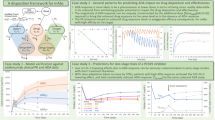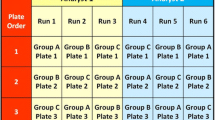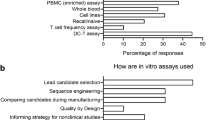Abstract
The rapidly increasing number of therapeutic biologics in development has led to a growing recognition of the need for improvements in immunogenicity assessment. Published data are often inadequate to assess the impact of an antidrug antibody (ADA) on pharmacokinetics, safety, and efficacy, and enable a fully informed decision about patient management in the event of ADA development. The recent introduction of detailed regulatory guidance for industry should help address many past inadequacies in immunogenicity assessment. Nonetheless, careful analysis of gathered data and clear reporting of results are critical to a full understanding of the clinical relevance of ADAs, but have not been widely considered in published literature to date. Here, we review visualization and modeling of immunogenicity data. We present several relatively simple visualization techniques that can provide preliminary information about the kinetics and magnitude of ADA responses, and their impact on pharmacokinetics and clinical endpoints for a given therapeutic protein. We focus on individual sample- and patient-level data, which can be used to build a picture of any trends, thereby guiding analysis of the overall study population. We also discuss methods for modeling ADA data to investigate the impact of immunogenicity on pharmacokinetics, efficacy, and safety.






Similar content being viewed by others
References
European Medicines Agency. Guideline on Immunogenicity Assessment of Biotechnology-Derived Therapeutic Proteins (draft). London: European Medicines Agency; 2015.
Singh SK. Impact of product-related factors on immunogenicity of biotherapeutics. J Pharm Sci. 2011;100:354–87.
Tovey MG, Legrand J, Lallemand C. Overcoming immunogenicity associated with the use of biopharmaceuticals. Expert Rev Clin Pharmacol. 2011;4(5):623–31.
Chirmule N, Jawa V, Meibohm B. Immunogenicity to therapeutic proteins: impact on PK/PD and efficacy. AAPS J. 2012;14(2):296–302.
Ratanji KD, Derrick JP, Dearman RJ, Kimber I. Immunogenicity of therapeutic proteins: influence of aggregation. J Immunotoxicol. 2014;11(2):99–109.
Kuriakose A, Chirmule N, Nair P. Immunogenicity of biotherapeutics: causes and association with posttranslational modifications. J Immunol Res. 2016;2016:1298473.
Casadevall N, Nataf J, Viron B, Kolta A, Kiladjian JJ, Martin-Dupont P, et al. Pure red-cell aplasia and antierythropoietin antibodies in patients treated with recombinant erythropoietin. N Engl J Med. 2002;14(346):469–75.
Schmidt E, Hennig K, Mengede C, Zillikens D, Kromminga A. Immunogenicity of rituximab in patients with severe pemphigus. Clin Immunol. 2009;132(3):334–41.
Banugaria SG, Prater SN, Ng YK, Kobori JA, Finkel RS, Ladda RL, et al. The impact of antibodies on clinical outcomes in diseases treated with therapeutic protein: lessons learned from infantile Pompe disease. Genet Med. 2011;13(8):729–36.
Sailstad JM, Amaravadi L, Clements-Egan A, Gorovits B, Myler HA, Pillutla RC, et al. A white paper—consensus and recommendations of a global harmonization team on assessing the impact of immunogenicity on pharmacokinetic measurements. AAPS J. 2014;16(3):488–98.
Smith A, Manoli H, Jaw S, Frutoz K, Epstein AL, Khawli LA, et al. Unraveling the effect of immunogenicity on the PK/PD, efficacy, and safety of therapeutic proteins. J Immunol Res. 2016;2016:2342187.
Food and Drug Administration. Guidance for Industry (Draft): Immunogenicity Assessment for Therapeutic Protein Products. Rockville: US Department of Health and Human Services, FDA, Center for Drug Evaluation and Research; 2014.
Food and Drug Administration. Draft Guidance for Industry: Assay Development and Validation for Immunogenicity Testing of Therapeutic Protein Products. Rockville: US Department of Health and Human Services, FDA, Center for Drug Evaluation and Research; 2016.
Shankar G, Arkin S, Cocea L, Devanarayan V, Kirshner S, Kromminga A, et al. Assessment and reporting of the clinical immunogenicity of therapeutic proteins and peptides-harmonized terminology and tactical recommendations. AAPS J. 2014;16(4):658–73.
Wang YM, Wang J, Hon YY, Zhou L, Fang L, Ahn HY. Evaluating and reporting the immunogenicity impacts for biological products—a clinical pharmacology perspective. AAPS J. 2016;18(2):395–403.
Wang YM, Fang L, Zhou L, Wang J, Ahn HY. A survey of applications of biological products for drug interference of immunogenicity assays. Pharm Res. 2012;29(12):3384–92.
Gunn GR 3rd, Sealey DC, Jamali F, Meibohm B, Ghosh S, Shankar G. From the bench to clinical practice: understanding the challenges and uncertainties in immunogenicity testing for biopharmaceuticals. Clin Exp Immunol. 2016;184(2):137–46.
YERVOY. (ipilimumab) [package insert]. Bristol-Myers Squibb Company: Princeton; 2017.
KEYTRUDA. (pembrolizumab) [package insert]. Whitehouse Station (NJ): Merck & Co. Inc.; 2016.
DARZALEX. (daratumumab) [prescribing information]. Horsham (PA): Janssen Biotech, Inc.; 2016.
ERBITUX. (cetuximab) [prescribing information]. ImClone LLC, a wholly-owned subsidiary of Eli Lilly: Indianapolis (IN); 2016.
TECENTRIQ. (atezolizumab) [prescribing information]. South San Francisco: Genentech, Inc.; 2016.
CIMZIA. (certolizumab pegol) [prescribing information]. Smyrna: UCB, Inc.; 2016.
Tatarewicz SM, Mytych DT, Manning MS, Swanson SJ, Moxness MS, Chirmule N. Strategic characterization of anti-drug antibody responses for the assessment of clinical relevance and impact. Bioanalysis. 2014;6(11):1509–23.
Gunsior, M. Implications of Immunogenicity in Drug Development. Global bioanalytical services: white paper [Internet]. 2017 May 15 [cited 2017 Sep 28]. Available from: http://www.covance.com/content/dam/covance/assetLibrary/whitepapers/adawhitepaperpdf.pdf.
Gorovits B, Clements-Egan A, Birchler M, Liang M, Myler H, Peng K, et al. Pre-existing antibody: biotherapeutic modality-based review. AAPS J. 2016;18(2):311–20.
Agrawal S, Statkevich P, Bajaj G, Feng Y, Saeger S, Desai DD, et al. Evaluation of immunogenicity of nivolumab monotherapy and its clinical relevance in patients with metastatic solid tumors. J Clin Pharmacol. 2017;57(3):394–400.
Mytych DT, Hock MB, Kroenke M, Jawa V, Kaliyaperumal A, Zhou Y. A proposal to redefine clinical immunogenicity assessment. AAPS J. 2017;19(3):599–602.
Passey C, Mora J, Dodge R, Gibiansky L, Sheng J, Roy A, et al. An integrated assessment of the effects of immunogenicity on the pharmacokinetics, safety, and efficacy of elotuzumab. AAPS J. 2017;19(2):557–67.
Lecluse LL, Driessen RJ, Spuls PI, de Jong EM, Stapel SO, van Doorn MB, et al. Extent and clinical consequences of antibody formation against adalimumab in patients with plaque psoriasis. Arch Dermatol. 2010;146(2):127–32.
Zhou L, Hoofring SA, Wu Y, Vu T, Ma P, Swanson SJ, et al. Stratification of antibody-positive subjects by antibody level reveals an impact of immunogenicity on pharmacokinetics. AAPS J. 2013;15(1):30–40.
Menting SP, van Lümig PP, de Vries AC, van den Reek JM, de Jong EM, Spuls PI, et al. Extent and consequences of antibody formation against adalimumab in patients with psoriasis: one-year follow-up. JAMA Dermatol. 2014;150(2):130–6.
Creeke PI, Farrell RA. Clinical testing for neutralizing antibodies to interferon-β in multiple sclerosis. Ther Adv Neurol Disord. 2013;6(1):3–17.
Calabresi PA, Giovannoni G, Confavreux C, Galetta SL, Havrdova E, Hutchinson M, et al. AFFIRM and SENTINEL Investigators. The incidence and significance of anti-natalizumab antibodies: results from AFFIRM and SENTINEL. Neurology. 2007;69(14):1391–403.
Aubin F, Carbonnel F, Wendling D. The complexity of adverse side-effects to biological agents. J Crohns Colitis. 2013;7(4):257–62.
Pichler WJ. Adverse side-effects to biological agents. Allergy. 2006;61(8):912–20.
Gibiansky L, Gibiansky E. Immunogenicity in PK of monoclonal antibodies: detection and unbiased estimation of model parameters. Proceedings of the Population Approach Group 2013 Annual meeting; 2013 Jun 11–14; Glasgow, Scotland. Available at: http://www.quantpharm.com/pdf_files/PAGE_2013_Immunogenicity_Poster.pdf.
Perez Ruixo JJ, Ma P, Chow AT. The utility of modeling and simulation approaches to evaluate immunogenicity effect on the therapeutic protein pharmacokinetics. AAPS J. 2013;15(1):172–82.
Bajaj G, Wang X, Agrawal S, Gupta M, Roy A, Feng Y. Model-based population pharmacokinetic analysis of nivolumab in patients with solid tumors. CPT Pharmacometrics Syst Pharmacol. 2017;6(1):58–66.
Diao L, Hang Y, Othman AA, Nestorov I, Tran JQ. Population pharmacokinetics of daclizumab high-yield process in healthy volunteers and subjects with multiple sclerosis: analysis of phase I-III clinical trials. Clin Pharmacokinet. 2016;55(8):943–55.
Nader A, Beck D, Noertersheuser P, Williams D, Mostafa N. Population pharmacokinetics and immunogenicity of adalimumab in adult patients with moderate-to-severe hidradenitis suppurativa. Clin Pharmacokinet. 2017;56(9):1091–1102.
Gibiansky L, Passey C, Roy A, Bello A, Gupta M. Model-based pharmacokinetic analysis of elotuzumab in patients with relapsed/refractory multiple myeloma. J Pharmacokinet Pharmacodyn. 2016;43(3):243–57.
Yang H, Zhang J, Yu B, Zhao W. Statistical methods for immunogenicity. Boca Raton: Chapman and Hall/CRC Press; 2015.
Rup B, Pallardy M, Sikkema D, Albert T, Allez M, Broet P, et al. Standardizing terms, definitions and concepts for describing and interpreting unwanted immunogenicity of biopharmaceuticals: recommendations of the Innovative Medicines Initiative ABIRISK consortium. Clin Exp Immunol. 2015;181(3):385–400.
Anti-Biopharmaceutical Immunization: prediction and analysis of clinical relevance to minimize the RISK (ABIRISK) project [Internet]; 2017 [cited 2017 Sep 28]. Available from: http://www.abirisk.eu.
Bachelet D, Hässler S, Mbogning C, Link J, Ryner M, Ramanujam R, et al. ABIRISK consortium. Occurrence of anti-drug antibodies against interferon-beta and natalizumab in multiple sclerosis: a collaborative cohort analysis. PLoS One. 2016;11(11):e0162752.
Link J, Ramanujam R, Auer M, Ryner M, Hässler S, Bachelet D, et al. Clinical practice of analysis of anti-drug antibodies against interferon beta and natalizumab in multiple sclerosis patients in Europe: a descriptive study of test results. PLoS One. 2017;12(2):e0170395.
OPDIVO. (nivolumab) [package insert]. Bristol-Myers Squibb Company: Princeton (NJ); 2017.
Morrissey KM, Yuraszeck TM, Li CC, Zhang Y, Kasichayanula S. Immunotherapy and novel combinations in oncology: current landscape, challenges, and opportunities. Clin Transl Sci. 2016;9(2):89–104.
Statkevich P, Passey C, Park J, Saeger S, Bello A, Roy A, et al. Assessment of the immunogenicity of nivolumab (nivo) and ipilimumab (ipi) in combination and potential impact on safety and efficacy in patients with advanced melanoma. Clin Pharmacol Ther 2016;99. https://doi.org/10.1002/cpt.310. Abstract available at: http://onlinelibrary.wiley.com/doi/10.1002/cpt.310/epdf.
Zhu L, Chan P, Vezina H, Wang X, Feng Y, Statkevich P, et al. Model-based assessment of drug-drug interaction and immunogenicity on the pharmacokinetics (PK) of nivolumab and ipilimumab in combination in advanced melanoma patients. Clin Pharmacol Ther 2016;99. https://doi.org/10.1002/cpt1310.
European Medicines Agency. Guideline on Similar Biological Medicinal Products Containing Biotechnology-Derived Proteins as Active Substance: Non-Clinical and Clinical Issues. London: European Medicines Agency; 2014.
Food and Drug Administration. Draft Guidance for Industry: Considerations in Demonstrating Interchangeability With a Reference Product. Rockville: US Department of Health and Human Services, FDA, Center for Drug Evaluation and Research; 2017.
Food and Drug Administration. Guidance for Industry: Scientific Considerations in Demonstrating Biosimilarity to a Reference Product. Rockville: US Department of Health and Human Services, FDA, Center for Drug Evaluation and Research; 2015.
Pineda C, Castañeda Hernández G, Jacobs IA, Alvarez DF, Carini C. Assessing the immunogenicity of biopharmaceuticals. BioDrugs. 2016;30(3):195–206.
Vultaggio A, Petroni G, Pratesi S, Nencini F, Cammelli D, Ferraro A, et al. How the immune system responds to therapeutic biological agents. J Int Med Res. 2016;44(1 suppl):38–42.
Vultaggio A, Petroni G, Pratesi S, Nencini F, Cammelli D, Milla M, et al. Circulating T cells to infliximab are detectable mainly in treated patients developing anti-drug antibodies and hypersensitivity reactions. Clin Exp Immunol. 2016;186(3):364–72.
Pandey GS, Sauna ZE. Pharmacogenetics and the immunogenicity of protein therapeutics. J Interf Cytokine Res. 2014;34(12):931–7.
Schuck RN, Grillo JA. Pharmacogenomic biomarkers: an FDA perspective on utilization in biological product labeling. AAPS J. 2016;18(3):573–7.
Acknowledgments
Professional medical writing and editorial assistance were provided by Stephan Lindsey, PhD, Melissa Kirk, PhD, and Cara Hunsberger at StemScientific, an Ashfield Company, funded by Bristol-Myers Squibb.
Research Support
This study was supported by Bristol-Myers Squibb.
Author information
Authors and Affiliations
Corresponding author
Ethics declarations
Conflict of Interest
C. Passey, S. Suryawanshi, K. Sanghavi, and M. Gupta are all employed by Bristol-Myers Squibb.
Additional information
The submitted manuscript is an original work and has not been submitted for publication elsewhere.
Rights and permissions
About this article
Cite this article
Passey, C., Suryawanshi, S., Sanghavi, K. et al. Reporting, Visualization, and Modeling of Immunogenicity Data to Assess Its Impact on Pharmacokinetics, Efficacy, and Safety of Monoclonal Antibodies. AAPS J 20, 35 (2018). https://doi.org/10.1208/s12248-018-0194-9
Received:
Accepted:
Published:
DOI: https://doi.org/10.1208/s12248-018-0194-9




